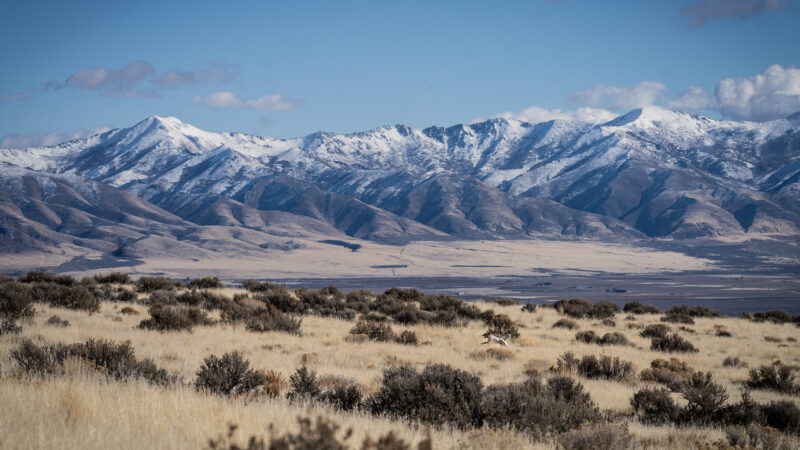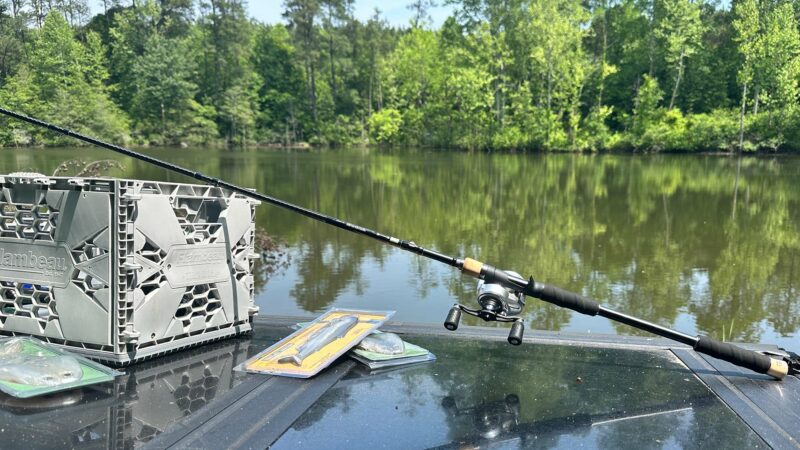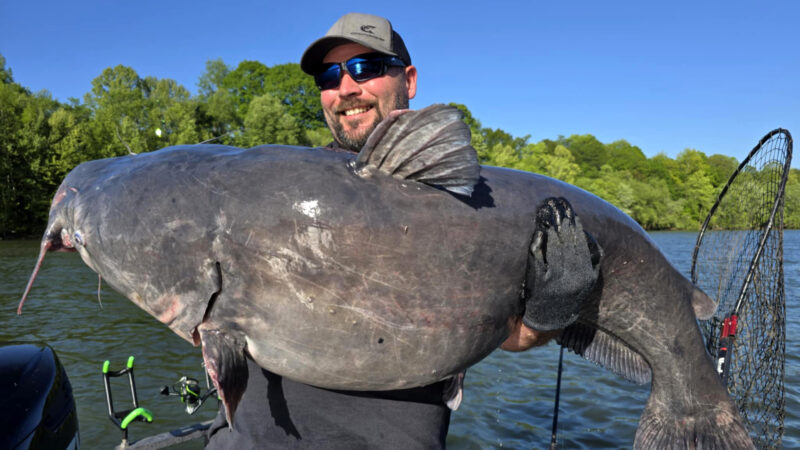No Other Fish Has Divided Anglers Like Landlocked Salmon
This story, “Making Up Salmon Water,” appeared in the May 1953 issue of Outdoor Life.
A stiff northwester was giving Moosehead Lake the full treatment. Even the big cabin cruisers were standing on end, and the 18-foot square-sterned guide’s canoe in which I found myself an unenthusiastic passenger leaped and tossed like a destroyer in a typhoon. It seemed to me like an excellent time to go back to camp — if we could get there — and just wait until tomorrow. But not to that leathery-hued old son of Maine, Tom Hardy.
“It’s makin’ up salmon water now,” he said approvingly, scanning the tumbling horizon. He angled the light craft skillfully into the breakers along the rocky shoreline. “Tie on a Black Ghost and lay it just as close to shore as you can.”
I looked around to see if he was kidding. He wasn’t. He expected me to let go of the gunwales, tie on a streamer, and cast it into the teeth of this tornado. What else could I do? Poking the gut through the streamer eye was like threading a needle, but I made it and the casting took care of itself. All I did was lift the rod and let the gale whip the streamer shoreward into the creaming surf.
On about the tenth toss I hooked a salmon. It darted out of the spume and belted the streamer in a burst of spray. At the prick of the barb it vaulted into the air like a silvery meteor, and then did it again. Having set the keynote, it ripped 30 yards of line off my reel and hurled itself out of water again. Then it began to fight. It shook, rolled, bored. Once it danced 10 feet across the waves on its tail. A second later it flashed toward the canoe and dived under it while I clawed in slack.
“Lively fish,” Tom commented mildly.
I forgot the cold and the discomfort as I clung to the bucking rod and watched that piece of fighting machinery go through its act. It combined the acrobatics of the smallmouth bass and the bulldog tenacity of the squaretail trout and added a few tricks of its own. At last it came in. weaving tired circles alongside the canoe, but even then it had enough fight left to leap over the net handle before being scooped up — 5 ½ pounds of silver dynamite.
That was my introduction to Salmo salar sebago, the battling landlocked salmon, flaunting St. Andrew’s crosses on his gallant, gleaming sides. In the years that have followed I’ve furthered the acquaintance in the Rangeley, Grand Lake, St. John, and other northland waters, and I have found him the same uncompromising warrior wherever our paths have crossed.
I’ve discovered other things about him too. No other gamefish has divided his enthusiastic followers into so many opposing camps, each with its own almost sacred beliefs. From the time the ice leaves the cold-water lakes until it once more skims the coves in autumn, these anglers come with their lures and their theories — surf ace trollers and deep trollers, fast trollers and slow trollers, fly casters and bait fishermen, spinners and hardware draggers, and the metalline fraternity. Some like it rough, others calm; some prefer it hot, others cold.
The salmon has his preferences too. At times he feeds selectively on smelt, worms, and insects as well as on such unnourishing fare as spinners, spoons, streamers, dry flies, wet flies, and nymphs. At other times he shuns all of these, and on those occasions I’m sure that only a well-placed depth charge would cause him to rise.
You’d think, under these circumstances, that anglers would tread softly and be guarded in their remarks. Instead, each will eagerly press his doctrines upon you, and hell hath no fury like a salmon angler questioned.
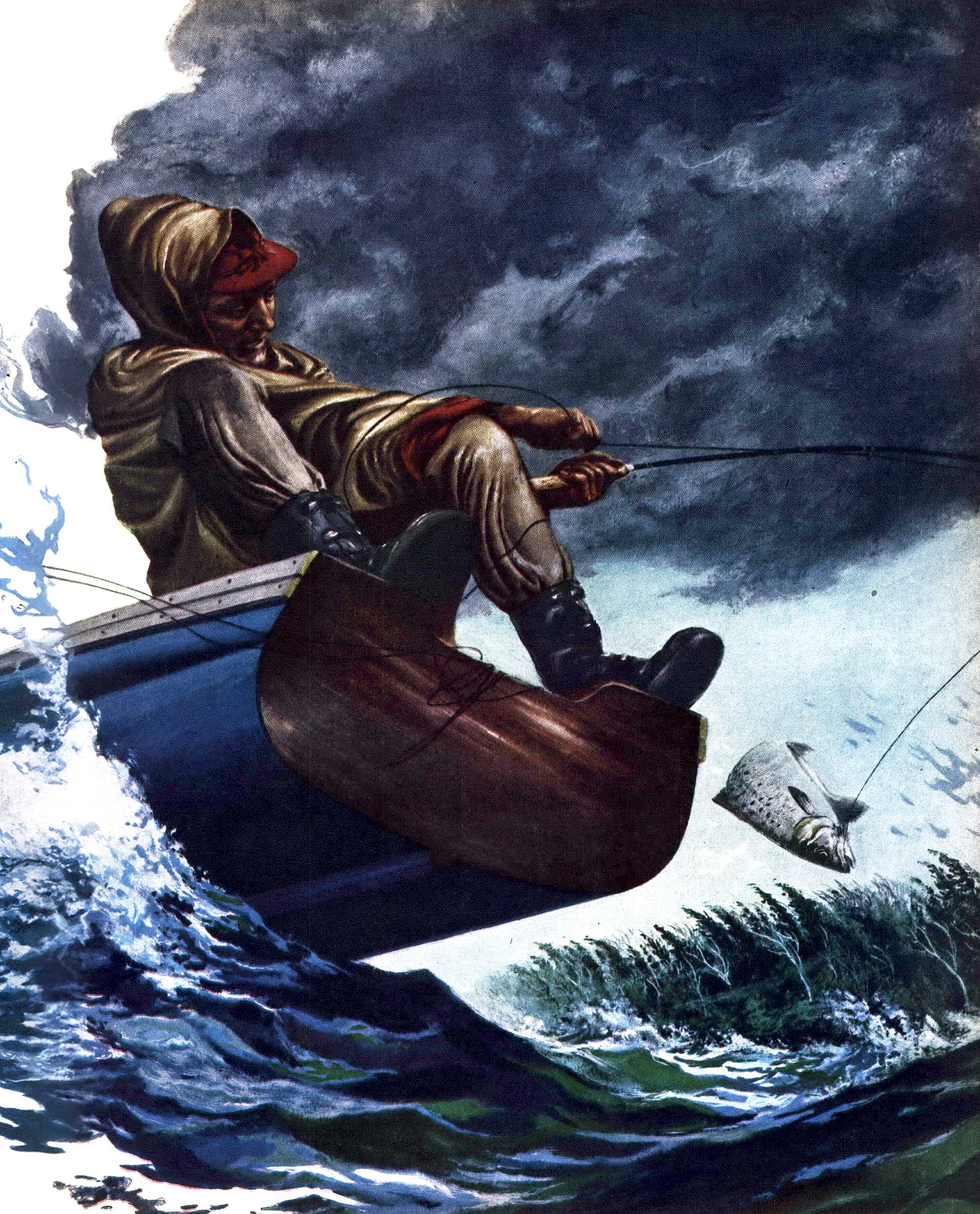
Actually no one knows much about the landlocked salmon. Even its origin is veiled in mystery. Some scientists say the landlock is descended from the Atlantic salmon, an off shoot which was trapped in its upstream spawning beds during some prehistoric renovation of the world. Others claim that once all salmon were fresh-water fish and that the Atlantic is a Johnny-come-lately variety that heard the call of the sea. Whatever he is or wherever he came from doesn’t much matter to the angler. The important thing is that landlocked salmon evolved and flourished in four great river basins of Maine and Quebec and that today, through widespread stocking, its range includes the entire Northeast.
One of the first problems the land locked-salmon angler runs into is where to locate his quarry. Bass, muskies, and wall-eyes invariably frequent certain typical localities throughout the season. Landlocks are here today and somewhere else tomorrow. The fact that they’re in a particular area at ice-out is no indication that they’ll still be there a couple of weeks later.
This nomadic tendency was impressed upon me in a highly embarrassing manner a few years back. For several seasons I’d fished a certain island-studded section of Maine’s Sebago Lake between ice-out and early May and had had consistently good results. Flushed with these successes, I volunteered to “guide” a friend on a Memorial Day expedition to this same lake.
All the professional guides were engaged for the holiday. In fact, some who had retired long since got back in harness to accommodate the visiting firemen. A young Southern couple on their first trip to Maine had been forced to settle for a gentleman who must have cast his first vote for President Grant. We had a lot of fun ribbing them at breakfast that morning when the old fellow showed up. Just as we left the lodge the girl said uneasily, “Ah declare Ah’m ashamed to have that pore ol’ man row Bob an’ me around the lake. Ah’m sure he’ll have a heart attack.”
We passed them 100 yards from shore, waving as we plowed past with the outboard at half-throttle. The old man rowed sedately, resting on his oars after every few strokes. He never did make it out to the islands, and we didn’t see the party again all day. We cast and trolled around the entire archipelago. At noon my companion volunteered that the biggest thrill in landlock fishing must be getting one of the critters to strike.
“Don’t worry,” I assured him. “They will.”
We stuck with it all that long, hot afternoon, but we didn’t see a single salmon. Anglers in boats fishing near us didn’t do any better. At dusk we saw the old gentleman rowing home with the Southern couple — and four nice landlocks in the bottom of his boat. He knew there wouldn’t be any salmon around the islands that time of year, and he knew where they’d gone.
Sometimes, though, finding landlocks is easy. They follow the smelt, their principal item of diet, and when smelt run up the rivers to spawn the landlocks go there too. Every spring, soon after ice-out, millions of Sebago smelt ascend the Songo River. The salmon follow them, and in the old days the fishermen followed the salmon. The ensuing slaughter was terrific, so bad that authorities wisely put a stop to it. The river is posted now and the fishing is restricted to 100 yards or so upstream from the mouth.
Hundreds of salmon hang around the flats off the river’s mouth, waiting for the smelt to come down. Scores of anglers go after them, and the resulting rhubarb would please the most exacting Dodger fan. When the run is on the area assumes some of the aspects of the Battle of Midway. Cabin cruisers, outboards, double-enders, skiffs, and canoes zigzag back and forth, dragging smelt, streamers, spinners, spoons, and worms. Lines get crossed, tempers flare. I was there one day when an impromptu boarding party took place, and salmon came over the gunwales by the dozen.
In early spring when birch leaves are the size of a mouse’s ear you’ll find landlocks hugging the rocky shores, often in only a foot or so of water, letting the warm sun thaw the winter chill from their lean, hard bodies. On windy days they’re usually on the side where the waves pile in, cruising the churned-up waters for wind-driven smelt.
You can either troll or cast streamer flies for landlocks — Green Ghost, 9-3, Supervisor, Dark Tiger — they’re all good. Casting is more fun, but trolling covers more water. The ideal method is a combination of the two — the man at the stern trolling while the man up forward casts toward shore. You can really blanket the area that way.
In trolling there’s always the danger of snapping a leader or even a rod tip on the strike, for salmon hit with savage fury. One good way to prevent damage is to prop your rod against the gunwale, pointing aft, and leave it there. When a salmon smacks the lure he’s likely to hook himself and announce his presence with a long, loud zzzzzzz of the reel, and to hear that signal is one of the greatest thrills this kind of fishing offers.
Besides your 30 yards of fly line, you need at least 100 yards of backing. Sounds funny, doesn’t it, for a fish that seldom goes heavier than five or six pounds? I thought so, too, until a big landlock smashed my Gray Wulff at Upper Dam and smoked off 90 feet of line and 50 yards of backing in one screaming run. It was all I had. I pointed the rod at him until the line went ping. That’s all.
Besides streamers you can troll sewn smelt or even small spinners on fly-rod tackle. But whichever way you take them you’re in for a battle. With your hands full of rampaging salmon, leaping high, wide, and handsome, some nincompoop within earshot is certain to warn you to keep a tight line. It’s the classic advice always given on such occasions, but nothing living, except maybe an octopus, could carry it out.
Albert Dixon Simmons, the outdoor photographer, has a reel of ultra-slow motion pictures of leaping landlocks which vividly show what a man’s up against. One salmon turns a complete cartwheel, another flings itself in a four-foot sidesnap, and still another touches nose to tail three times in mid-air. In each case, there’s enough slack line hanging from their jaws to fly a kite
On mirror-calm days salmon for sake the shoreline or hide under rocks. But even at such times you can still stir up an occasional fish if you work at it hard enough One day when Rangeley Lake lay like a sheet of polished silver reflecting its spruce-grown shores, Phil Grant showed me a useful trick. We’d trolled all the way from Greenvale Cove to South Cove without a touch on his Gray Ghost or my 9-3. At last Phil headed for deep water and cut the motor. He tied on a small Silver Doctor and handed me a Jock Scott.
I made a long cast, then lighted a cigarette. fter a few minutes I began stripping in line. A second later a silver streak shattered the surface and a big salmon took to the air. He smacked back into the water and disappeared with the Jock Scott in his jaw.
“Let it sink way down,” he told me, “and bring it in slowly in little twitches.”
I made a long cast, then lighted a cigarette. After a few minutes I began stripping in line. Nothing happened, but about the fourth take, just as I picked it up, the rod arched sharply. A second later a silver streak shattered the surface and a big salmon took to the air. He smacked back into the water and disappeared with the Jock Scott in his jaw.
“That,” Phil said, “will give you an idea of how it works.”
It did, and to make the lesson stick, Phil took a 3 1/2-pounder on his Silver Doctor a few minutes later.
You might also try shortening your line and trolling your lm·e right in the bubbling wake of the outboard. A short line is effective in top-water salmon trolling under any conditions. Troll fast. I’ve had salmon smack a trolled streamer while the boat was heading for new fishing grounds with the motor wide open. One day I’d hardly left the dock when a salmon fielded a 9-3 skimming 15 feet behind the propeller.
Action is the important factor in a ft lure, whether it’s live bait, flies, or plugs. Most plugs have built-in action, but you have to supply the commotion to a fly. Some guides will tell you to keep raising and lowering the rod tip as you troll. On rough days the pitching of the boat will do this for you, and on calm days the action is imparted by the wash of the propeller. But, frankly, calm water isn’t salmon water — except at dusk — and even then the fishing is likely to be pretty slow. It pays to persevere, though, for as Hank Werner says, “It could happen.”
Like the day at Mooselookmeguntic when a friend and I trolled for four hours over a flat surface without getting a strike. You tend to relax at such times, and we’d almost fallen asleep. I’rr1 not sure that I wasn’t dozing when all of a sudden my reel let out a wild screech. It shocked me wide awake, and at first I thought my companion was playing the oldest and lowest of all angling tricks — giving my line a yank. Then the reel howled again, and look, Ma, no hands! I made a dive for it. A three-pound landlock vaulted into the air. He put on a brilliant exhibition before coming into the boat — the only fish of the day.
Landlock run smaller now, the old-timers will tell you sadly, than they did in the good old days. It’s true, unfortunately. Forty or 50 years ago 10 to 15-pounders weren’t uncommon, and it was in 1907 that the world-record landlock was caught in Sebago Lake. It weighed 22 pounds 8 ounces. Today the average weight is less than 6 pounds, thanks chiefly to increased fishing pressure, less abundant feed, and, most important of all, the widespread use of smaller St. John salmon for stocking.
But some pretty sizable fish get caught now and then. Each year a few more anglers join the exclusive ranks of Maine’s One-That-Didn’t-Get-Away Club by catching landlocks weighing over 10 pounds. And a few years ago a 22-pounder was hefted out of the Fish River Chain during stripping operations in the fall spawning season.
As spring advances, salmon leave the shallow water near shore, but you’ll still find them close to the surf ace of deeper water that hasn’t warmed up. This is the time when dry-fly fishermen come into their own. In the quiet dusk you’ll hear the fish breaking and you’ll see the rings made by their rises ripple across the tranquil surface.
Bill Riviere was the one who introduced me to the dry-fly fishing at Indian Rock near the mouth of the Kennebago. A fleet of trollers, silhouetted against the sunset sky, circled endlessly over the bars outside. Bill cut the motor and paddled slowly into the river. As we rounded a bend I heard a telltale splash and saw the spreading circles.
“Tie on a good-size fly,” Bill said, “and prepare to defend yourself.”
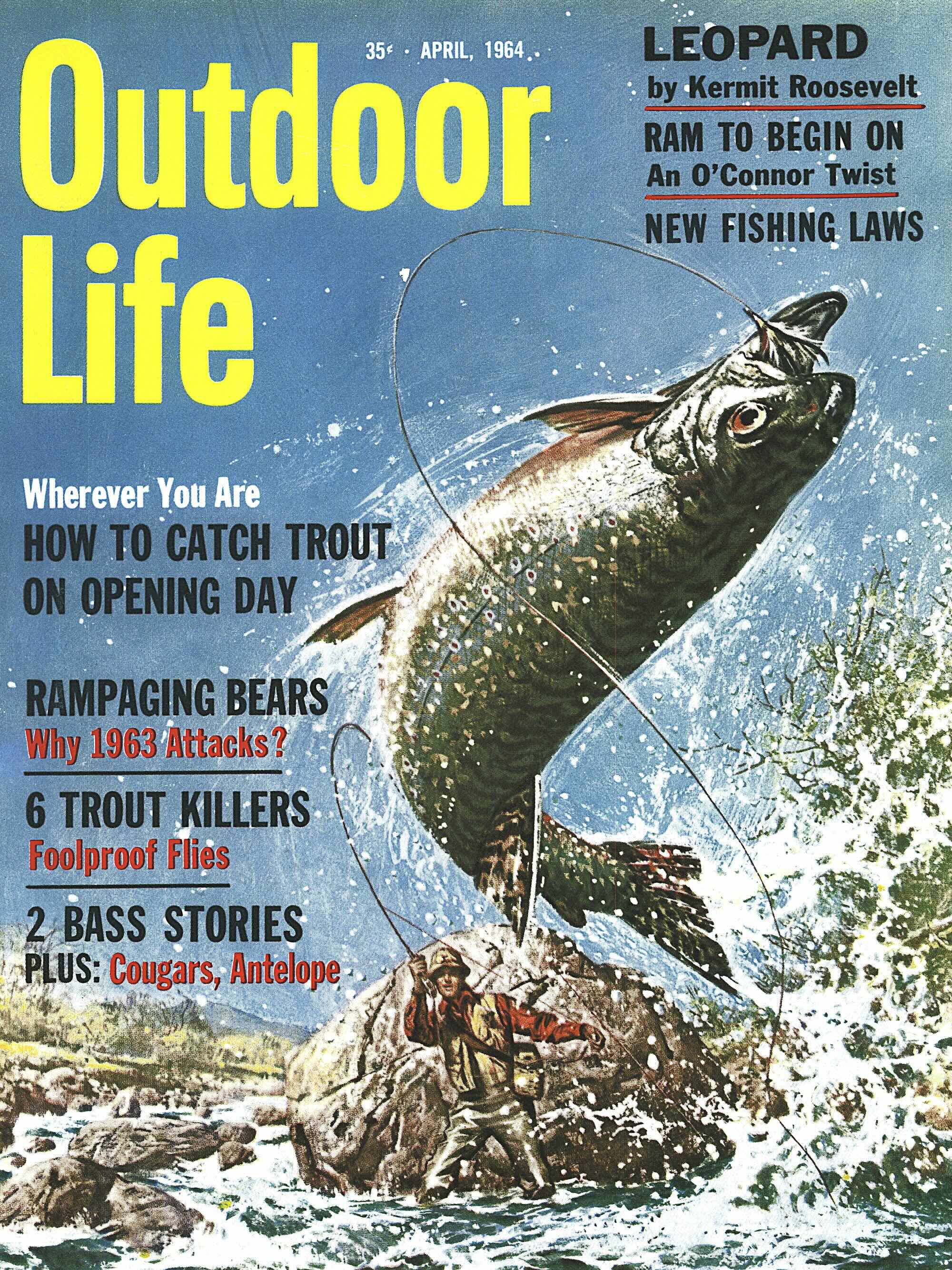
My fingers trembled a little as I complied. When they stop trembling I’ll give up fishing. A bulge flurried the surface as Bill ghosted the boat upstream, and I dropped the fly into the spreading ripples. It lay cocked for a second, dancing on the quiet water. Then it disappeared explosively and my rod doubled. My wrist ached before that fighting fool came over the side, but I couldn’t wait to unhook him and cast again. When one of those big battlers comes rampaging from below to paste a floating fly — brother, you can throw away the adrenalin.
The only bigger thrill for me is taking them in fast water, in a place like Rapid River where the currents run deep and black as the water swirls down to Umbagog. Or like the Androscoggin below Erroll, N. H., where the fishing is further complicated by the presence of floating pulpwood. This pulp is good stuff too. Salmon hang around log jams and feed on the bugs and grubs that fall out of the wood.
One of the largest salmon I ever hooked came from under a log pile-up. Hooked, I said. He lanced up and inhaled a big Wulff as I drifted it alongside the jam. His first towering leap landed him smack on top of the heap where he lay flopping. It gave me a funny feeling to see him bouncing around the woodpile. A helpless feeling, • too, for all I could do was stand there watching until he fell between two logs. His tail looked like a turkey gobbler’s as it disappeared from sight. The leader snapped a second later and away went my best chance, so far, for a mounting salmon.
When the hot summer days come the landlocks follow the smelt into deep water, and then’s when the metal-line boys go to work. The outfit most of them use is a series of four or five flashers the size of a man’s hand and separated with red beads, all strung on a wire leader and topped off with a No. 4 hook baited with smelt or a gob of night crawlers.
Read Next: A Grizzly Stole My Client’s Elk, Then Treed Me for 7 Hours
They troll this rig on copper or Monel line, use a stiff rod, and work in 100 to 200 feet of water around spring holes and ledges. I don’t find it as exciting as top-water fishing. The heavy lures make the rod throb as they spin through the water, and it takes a sizable fish to put up much of an argument on gear like that. Still, it has its champions, for the landlock is a prize on any kind of tackle.
Then comes autumn with its cooling waters, and the salmon, filled with a primitive urge, ascend the same streams down which they followed the smelt in spring. In the quiet headwaters they produce more of their kind. And the anglers go home, their theories battered but still firmly held, to argue endlessly until the ice once more leaves the northland lakes.
The post No Other Fish Has Divided Anglers Like Landlocked Salmon appeared first on Outdoor Life.
Source: https://www.outdoorlife.com/fishing/landlocked-salmon-fishing/


